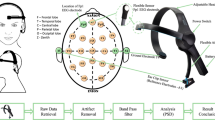Abstract
Numerous domestic and foreign studies have demonstrated that music can relieve stress and that listening to music is one method of stress relief used presently. Although stress-relief music is available on the market, various music genres produce distinct effects on people. Clinical findings have indicated that approximately 30 % of people listen to inappropriate music genres for relaxation and, consequently, their stress level increases. Therefore, to achieve the effect of stress relief, choosing the appropriate music genre is crucial. For example, a 70-year-old woman living in a military community since childhood might not consider general stress-relief music to be helpful in relieving stress, but when patriotic songs are played, her autonomic nervous system automatically relaxes because of her familiarity with the music style. Therefore, people have dissimilar needs regarding stress-relief music. In this paper, we proposed a personalized stress-relieving music recommendation system based on electroencephalography (EEG) feedback. The system structure comprises the following features: (a) automated music categorization, in which a new clustering algorithm, K-MeansH, is employed to precluster music and improve processing time; (b) the access and analysis of users’ EEG data to identify perceived stress-relieving music; and (c) personalized recommendations based on collaborative filtering and provided according to personal preferences. Experimental results indicated that the overall clustering effect of K-MeansH surpassed that of K-Means and K-Medoids by approximately 71 and 57 %, respectively. In terms of accuracy, K-MeansH also surpassed K-Means and K-Medoids.











Similar content being viewed by others
References
[Online] eSense(tm) Meters (2015) Available: http://developer.neurosky.com/docs/doku.php?id=esenses_tm. Accessed on 26 Aug 2015
[Online] MIRtoolbox (2015) Available: https://www.jyu.fi/hum/laitokset/musiikki/en/research/coe/materials/mirtoolbox. Accessed on 26 Aug 2015
[Online] Spotify (2005) https://www.spotify.com. Accessed 23 Aug 2015
Blood AJ et al (1999) Emotional responses to pleasant and unpleasant music correlate with activity in paralimbic brain regions. Nat Neurosci 2:382–387
Brecheisen S et al. (2006) Hierarchical genre classification for large music collections. IEEE International Conference on Multimedia and Expo, Toronto, pp. 1385–1388
Cabredo R et al (2013) Discovering emotion-inducing music features using EEG signals. J Adv Comput Intell Intell Inf 17:362–370
Carter JR et al (2005) Forearm neurovascular responses during mental stress and vestibular activation. Am J Physiol Heart Circ Physiol 288:904–907
Chang C-J et al (2008) Application of music therapy on competitive state anxiety -the example of chaoyang university of technology female basketball team. J Phys Educ National Chung Hsing Univ Taiwan 9:67–68
Esther M, Wong KY (2003) Effects of music on patient anxiety. AORN J 77:396–401
Hsiao T-Y, Hsieh H-F (2009) Nurse’s experience of using music therapy to relieve acute pain in a post-orthopedic surgery patient. J Nurs Taiwan 56(4):105–110
Hsieh J-K (2010) Headache, migraine music therapy. J Health World Taiwan 292:83–84
Kim J, André E (2008) Emotion recognition based on physiological changes in music listening. IEEE Trans Pattern Anal Mach Intell 30:2067–2083
Kim YE et al. (2010) Music emotion recognition: a state of the art review. International Society for Music Information and Retrieval Conference, Utrecht, pp. 255–266
Lartillot O, Toiviainen PA (2007) Matlab toolbox for musical feature extraction from audio. International Conference on Digital Audio Effects, Bordeaux, pp. 237–244
Lee OK et al (2005) Music and its effect on the physiological responses and anxiety levels of patients receiving mechanical ventilation: a pilot study. J Clin Nurs 14(5):609–620
Li SZ (2000) Content-based audio classification and retrieval using the nearest feature line method. IEEE Trans Speech Audio 8:619–625
Lie L et al (2006) Automatic mood detection and tracking of music audio signals. IEEE Trans Audio Speech Lang 14:5–18
Lin H-C, Chen S-L (2007) Using focus groups to explore the group music therapy experience of long term care elderly. J Nurs Taiwan 54(2):38–46
MacQueen J (1967) Some methods for classification and analysis of multivariate observations. Proceedings of the Fifth Berkeley Symposium on Mathematical Statistics and Probability, University of California Press, Oakland, California, 1:281–297
Michele B, Gail A (2005) Music therapy for reducing surgical anxiety Association of Operating Room Nurses. AORN J 78:816–821
Moraska A et al. (2010) Physiological adjustments to stress measures following massage therapy: a review of the literature. Evid Based Complement Alternat Med 7(4):409–418
Odendaal JW et al (1994) Two-dimensional superresolution radar imaging using the MUSIC algorithm. IEEE Trans Antennas Propag 42:1386–1391
Park H-S, Jun C-H (2009) A simple and fast algorithm for K-medoids clustering. Expert Syst Appl 36:3336–3341
Shin Y-N, Luo T-H (2008) Applications of Kagayashiki music care in health care. J Taiwan Occup Ther Res Practice 4(1):27–33
Trevisan AA, Jones L (2011) Brain music system: standardized brain music therapy. IET Seminar on Assisted Living, 6 April 2011, London, pp. 1–4
Tung H-T, Chen K-M (2000) Implications of music therapy for elderly persons with dementia. J Long-Term Care Taiwan 10(3):296–306
27. Wang Y (2014) Music emotion cognition model and interactive technology. IEEE Workshop on Electronics, Computer and Applications, 8-9 May 2014, Ottawa, ON, pp. 269–272
Wold E et al (1996) Content-based classification, search, and retrieval of audio. IEEE MultiMedia 3:27–36
Yang Y-H et al (2008) A regression approach to music emotion recognition. IEEE Trans Audio Speech Lang 16:448–457
Acknowledgments
This work was supported by Ministry of Science and Technology (MOST) project of Taiwan [MOST 103-2221-E-415-021-] and [MOST 104-2221-E-415-003-].
Author information
Authors and Affiliations
Corresponding author
Rights and permissions
About this article
Cite this article
Chang, HY., Huang, SC. & Wu, JH. A personalized music recommendation system based on electroencephalography feedback. Multimed Tools Appl 76, 19523–19542 (2017). https://doi.org/10.1007/s11042-015-3202-4
Received:
Revised:
Accepted:
Published:
Issue Date:
DOI: https://doi.org/10.1007/s11042-015-3202-4




